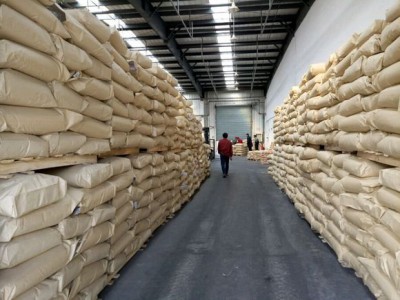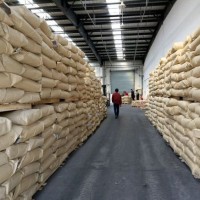絮凝劑主要用于給水和污水處理領域。它是添加到廢水中的聚合物凝結劑。在聚合物凝結劑溶解后,形成高分子聚合物。
高聚物的結構是線性結構,線的一端拉出一個微小的粒子,另一端拉出另一個微小的粒子,并起到兩個遠處粒子之間的橋梁作用,使粒子# ##逐漸變大,最終形成大顆粒絮狀物(俗稱絹花),加速顆粒沉降。 Flocculants are mainly used in the field of water supply and sewage treatment. It is a polymer coagulant added to wastewater. After the polymer coagulant dissolves, the polymer is formed.
The structure of polymer is a linear structure. One end of the line pulls out a tiny particle, the other pulls out another tiny particle, and acts as a bridge between two distant particles, which gradually enlarges the particle # and eventually forms a large particle floc (commo
nly known as silk flower), accelerating the particle settling.
The commo
nly used flocculant is polyacrylamide (PAM).
The im
portant co
ntrol co
nditions of flocculants are: 1. The dosage and its properties and the total suspended solids produced by co
ndensation need to be determined by experiments; 2. Kinetic conditions, especially in the process of rapid agitation, are very practical.
The project co
ntrol is not good, resulting in poor results; 3, other co
nditions are not very im
portant, adjusting dosage and mixing effect is very good, especially the co
ntrol of dynamic conditions, it is necessary to experience.
Underwater non-dispersible co
ncrete flocculant is a powdered bismuth admixture composed of water-soluble polymer and surfactant. It has strong anti-dispersibility and good fluidity, and realizes the self-leveling of underwater concrete.
Self-compacting, inhibit the dispersion of cement and aggregate during underwater construction, and do not pollute building water.
污水處理廠常用的外部碳源是甲醇,工業(yè)葡萄糖等。甲醇應該是最理想的反硝化補充碳源,但其高成本,高毒性和運輸困難逐漸被其他產(chǎn)品所取代。工業(yè)葡萄糖通常用作額外的碳源。過程測試水質測試中心在工業(yè)葡萄糖成分的測量和計算方面做得很好。在實驗室中,以1/100的比例添加工業(yè)葡萄糖,測量COD和BOD含量,并計算每10,000平方米污水的工業(yè)葡萄糖的理論劑量。劑量的劑量是根據(jù)在《給水排水設計手冊》的第五體積的多級活性污泥法脫氮處理的碳源的計算公式根據(jù)所述過程實驗的結果計算,并且計算的工業(yè)葡萄糖的劑量。碳源劑量應在上限和下限之內。上限劑量應確保出水COD值不超過標準。下限劑量應確保反硝化細菌的C/N比,以確保總出水氮達到標準。去除1千克總氮需要4.2千克COD,1千克葡萄糖相當于1.1千克COD,因此需要3.9千克葡萄糖才能去除1千克總氮。九公里污水處理廠的日均處理能力為冬季每天20,000平方米,夏季每天50,000平方米。手動添加劑量方法,位置為第二級充氣生物過濾器的東側出水通道。劑量周期為2小時。污水用于在通道和清水箱中流動以自然地混合和混合藥物。同時,根據(jù)COD,氨氮和紫外線消毒室內全氮的在線監(jiān)測數(shù)據(jù),工藝技術人員實時調整工業(yè)葡萄糖用量,以滿足出水水質要求。
6. When the water temperature is high in summer, the dissolution time of PAM to polymer should be guaranteed for 1 hour. When the water temperature is low in winter, the dissolution time of flocculant polymer should be guaranteed for 1.5 hours. Incomplete dissolution will affect the use effect.
常用的絮凝劑是聚丙烯酰胺(PAM)。
絮凝劑重要的控制條件是:1。劑量與本身的性能和凝結產(chǎn)生的總懸浮固體,需要通過實驗確定; 2.動力學條件,特別是快速攪拌過程中的動力學條件,很多實際的
項目控制不好,導致結果不佳; 3,其他條件不是

很重要,調整劑量和混合效果非常好,特別是控制動態(tài)條件,有必要去體驗
水下非分散混凝土絮凝劑是由水溶性聚合物,表面活性物質等組成的粉狀鉍摻合料,具有很強的抗分散性和良好的流動性,實現(xiàn)了水下混凝土的自流平。
自密實,在水下施工期間抑制水泥和骨料的分散,不污染建筑用水。
當材料的水下焓在水中下降0.3至0.5米時,抗壓強度可以達到相同比例的陸上混凝土強度的70%或更高。
添加絮凝劑注意事項有以下6點:
1。不能直接添加到污水中。使用前必須將其溶解在水中,然后以一定的比例將水溶液加入污水中。
2。溶解產(chǎn)品的水應該是干凈的自來水。通常,自來水的pH值可以滿足配制的絮凝溶液的要求。
3。溶液的濃度通常為0.1至0.5%,即,將15g粉末加入1升水中。
4。由于酰胺剪切性能差,長時間和高速攪拌會導致產(chǎn)品降解并減少其使用。通常,攪拌速度優(yōu)選為60至120rpm。
5。在溶解過程中,添加絮凝劑的速度應盡可能慢,并將其慢慢撒入水的渦流中,以防止顆粒在進入水后相互粘連。
6。當夏季水溫較高時PAM對聚合物的溶解時間最好保證1小時。當冬季水溫較低時,絮凝聚合物的溶解時間最好保證1.5小時。不完全溶解會影響使用效果。






 很重要,調整劑量和混合效果非常好,特別是控制動態(tài)條件,有必要去體驗
很重要,調整劑量和混合效果非常好,特別是控制動態(tài)條件,有必要去體驗